Comprehensive Guide to Arson Investigation
Introduction
Welcome to our authoritative guide on Arson Investigation. Fire and arson investigation is a crucial field. It combines scientific knowledge, analytical skills, and legal expertise. This is in order to solve the puzzle of fires deliberately set to cause damage or harm. This guide is structured into detailed modules.
Each area focuses on a different aspect of fire scene investigations. In this post, we’re going to provide you with the knowledge needed to the ‘nuts and bolts’ of fire science and help you explore the many intricacies of the legal processes.
Whether you're a student aspiring to enter the fire arson field or a professional arson investigator looking to expand your knowledge, our aim is to provide you with invaluable intel on all things related to investigating arson.
Table of Contents
For educational enrichment, each module on fire arson is designed to build upon the last. This ensures a meaningful and comprehensive learning journey.
The Chemistry of Fire
Fire is an amazing natural phenomenon that originates from chemical combustion. The combination of fuel, heat and an oxidizing agent plays a role in this reaction.
Throughout an arson investigation, fire investigators must be able to understand this chemistry. This is because it helps determine the source of the fire.
Fire happens when a flammable substance mixes, with oxygen, under heat resulting in heat and specific combustion residues. This process, called oxidation, releases energy in the form of heat and light fueling the fire as it progresses.
Fire investigators are able to interpret clues at fire scenes by understanding the chemical processes involved.
For example, the existence of accelerants or residues might point to arson whereas the lack of such substances could imply accidental ignition.
Moreover, examining the makeup of fire debris and residues aids in identifying the fuel type used and offers clues about how the fire started and developed.
Fire Dynamics and Behavior
The way fire behaves is influenced by a mix of chemical processes. This allows it to change and become an unpredictable occurrence. Fire dynamics involve elements. Examples of these could be ignition source, fuel type, environmental factors and airflow patterns.
An important aspect of fire dynamics involves grasping how fires develop and move. Fires can display certain behaviors. These include flashover, backdraft, and fire whirls, based on the situation at hand. By taking a closer look at how fires grow, fire investigators can figure out where the fire started and how it spread. They look at burn patterns and heat transfer mechanisms. This helps the arson investigators piece together what events lead up to the fire. This way, they can begin to determine if it was accidental or intentional.
Furthermore, in order to evaluate risks from a fire and create fire fighting strategies, it’s vital to understand fire dynamics. By knowing how fire acts in certain scenarios, firefighters can better predict the movement of the fire. They’ll be able to use fitting tactics to manage and put out the flames. Thus, reducing damage to property and saving lives.
Types of Fires and Fire Causes
When investigating a fire, arson investigators must be able to distinguish between the types of fires and their origins. There are accidental, natural, and intentional fires. Let’s go over each of them in detail:
Accidental Fires
These often stem from circumstances like faulty wiring, cooking accidents, or improper disposal of smoking materials. Incidents such as these typically lack signs of premeditation or harmful intent. They can also occur due to mistakes with equipment or malfunctions.
Natural Fires
Contrary to the above, these fires are sparked by events such as lightning strikes or volcanic activities. These fires usually occur without influence or any human triggered factors.
Intentional Fires
These are also known as fire arson cases. They involve setting fires with the intent of causing harm or damage.
Fire arson can be driven by motives. These could include:
- Something to gain from the fire
- Revenge
- Psychological influences
If arson is suspected, a fire investigator will open an arson investigation to:
- Uncover tools
- Accelerants
- Any other proof that the start of the fire was deliberate.
Arson: An Overview
Definition and Types of Arson
We can define arson as deliberately setting fire with intent to cause damage.
It encompasses various types. These include:
Structural Arson:
Targeting buildings or dwellings.
Vehicle Arson:
Targeting automobiles or other vehicles.
Wildland Arson:
Igniting fires in natural environments.
The Psychology of Arsonists
The reasons for setting fires can differ greatly. However, they can offer clues into the mindset of those responsible. Throughout a fire scene investigation, arson investigators will:
Pinpoint Potential Persons of Interest
Some individuals who start fires may show signs of behavior or mental health issues while others might be driven by incentives, a thirst for revenge or a craving for recognition.
By taking a closer look at the makeup and behavioral tendencies of arsonists, arson investigators can gain insights into their motivators.
This understanding can also guide efforts to prevent incidents of arson through targeted interventions and security measures.
Historical Perspectives on Arson
Understanding the origins of arson can provide insights into how it has changed over time and how investigative methods have evolved.
Arson has been used throughout history - including in conflicts, protests and personal disputes - showcasing its nature as a criminal act.
By examining arson incidents and the investigative strategies employed during those times, present day arson investigators can enhance their skills.
Legal Foundations
Laws and Regulations Surrounding Arson
Fire arson laws can differ based on location. They typically focus on property damage, criminal intent, and endangerment. When it comes to fire scene investigation, these laws need to be well-understood.
Of course, different regions have varying views on arson as a crime. Oftentimes, this results in fines and imprisonment.The severity of the charges may rely on certain factors. These could include the extent of damage to the property, presence of individuals and the perpetrator’s intentions.
There’s no doubt that fire investigators need to be familiar with the laws in their area. This is especially true if they wish to handle the cases effectively.
The Role of Arson Investigators
The work of arson investigators is multifaceted. It requires a combination of:
- Technical expertise
- Analytical skills
- Attention to detail
Understanding Fire Codes and Standards
During a fire arson investigation, a certified fire investigator must understand fire codes and standards that help prevent fires and guide the investigation. This helps them to identify any deviations that may indicate foul play. Here are some examples of the most common fire codes and standards:
National Fire Protection Association (NFPA) Codes: NFPA code 1321, NFPA 921, and NFPA 1033 provide guidance on conducting an arson investigation (documentation, evidence collection, and analysis techniques.
International Building Code (IBC): Covers things that play a role in preventing fires (building materials, occupancy classifications, fire resistance ratings, and means of egress).
International Fire Code (IFC): Address aspects to safeguard lives and property (fire alarms, sprinkler systems, hazardous material storage, and emergency exits).
These codes and standards help fire investigators determine compliance and pinpoint any potential violations.
Since these fire investigators play a critical role in the criminal justice system, there are some key responsibilities they must take on when determining the cause and origin of fires. Here are some of them:
The Science of Fire Investigation
Fire Scene Examination:
For fire scene investigations, a certified fire investigator is one of the first responders to a fire scene. They will examine the site for any potential evidence of fire arson.
During the fire investigation, they’ll:
- Document the fire’s progression.
- Identify points of origin.
- Collect samples for analysis.
Fire Scene Analysis and Reconstruction
A certified fire investigator will analyze fire patterns, such as burn patterns on surfaces to reconstruct the events that lead up to the fire.
They’ll work to document evidence and reconstruct the scene that leverages their expertise in fire dynamics and forensic techniques. This information helps them understand the fire’s origin and progression.
Determining the Origin and Cause
When investigating a fire, it’s important to pinpoint precisely where the fire originated from as well as the cause. As discussed above, arson investigators will consider factors such as:
- Heat patterns
- Burn marks
- Potential ignition sources
This will help the fire investigators understand the circumstances that started the fire.
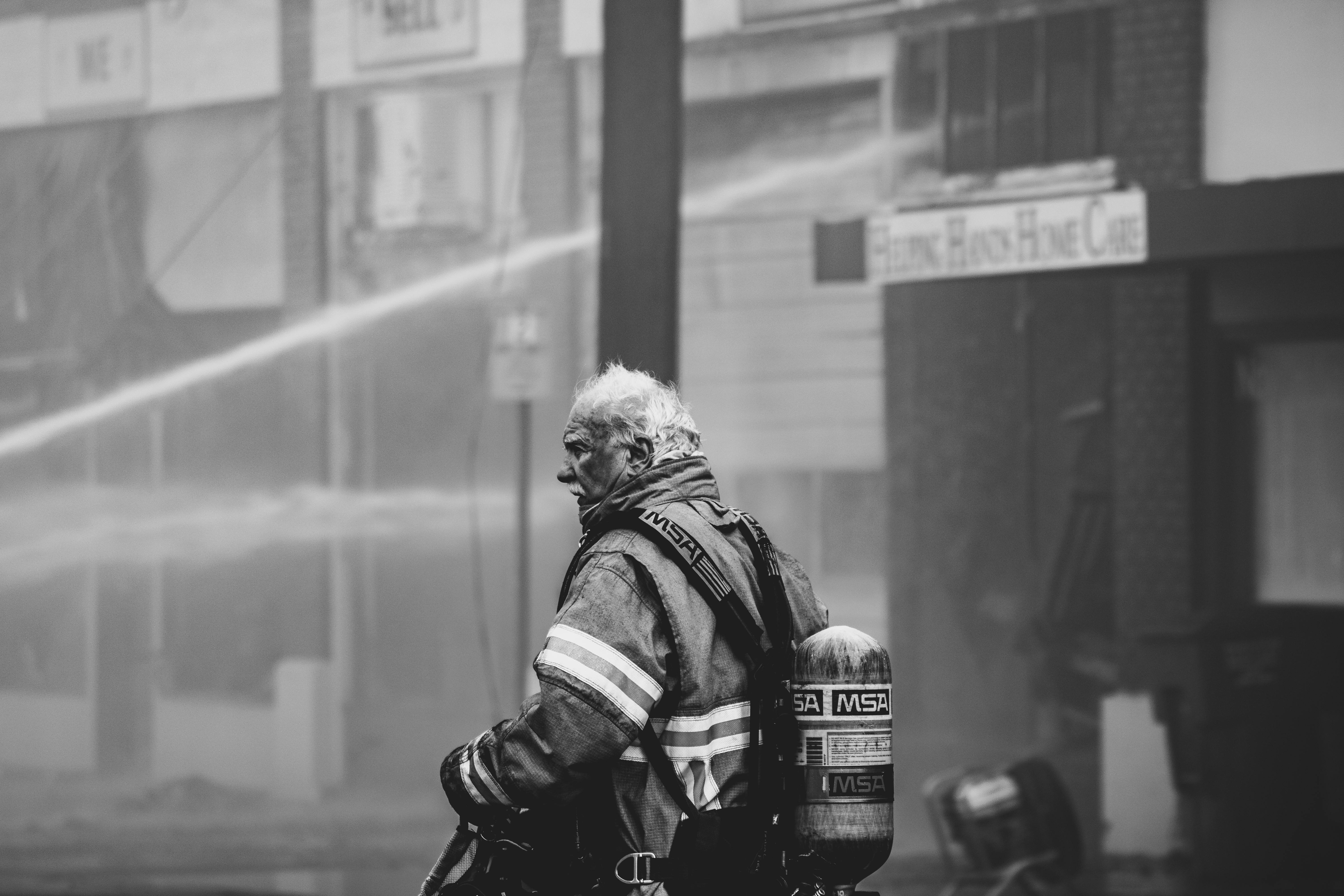
Fire Patterns and Their Interpretation
Fire patterns can be quite revealing throughout fire scene investigations. They can help an arson investigator interpret patterns within the fire’s behavior. They consider factors such as:
V-patterns: Resemble a “V” shape. They’re formed when flames travel upwords and help fire investigators determine the direction the fire spread as well as the origin.
Char depth: The extent of charring. It helps a fire investigator assess the severity of fire damage.
Heat discoloration: Changes in the color of the surface, caused by exposure to high temps. This provides an indication of the intensity and fire duration.
This allows the certified fire team to gain more insight into the fire’s dynamics and any potential accelerant use.
Tools and Techniques
Evidence Collection and Preservation
Arson investigators meticulously collect physical evidence from the fire scene.
This evidence could include:
- Debris
- Remnants of accelerants
- Electrical components
- Witness statements.
It’s imperative during the arson investigation to properly handle and preserve any and all evidence to ensure it’s admissibility in court.
Use of Technology in Investigation
Technology, such as drones equipped with thermal imaging cameras, will allow a fire investigator to survey the scene of the investigation from different angles. This technology also helps them detect heat sources that could indicate the presence of accelerants.
Fire investigation software for case management, like Blazestack, helps investigators write reports in minutes and ensures no details are missed. Here are a few ways arson investigators have relied on Blazestack:
- Fully Mobile: Use on multiple devices such as PC, tablet, and mobile.
- Automated: Increases efficiency by automating repetitive tasks.
- Productivity: Allows easy collaboration and data sharing across investigators.
- Detail Oriented: Allows fire investigators to capture case notes, scene interviews, and upload case documents with ease.
- User Friendly & Customizable: Easy to use and adjustable to individual workflows.
By utilizing arson investigation tools, arson investigators are able to be more productive, efficient, and ease their stress during an active investigation and in the case management that follows.
Interviewing Techniques for Witnesses and Suspects
During an arson investigation, interviews are useful and can uncover priceless information. The techniques used will vary. This is dependant on the interviewee’s relationship to the fire:
For witnesses: Open-ended questions and active listening.
For suspects: Questions are more structured and tactics like cognitive interviewing are employed.
Safety on the Scene
Personal Protective Equipment (PPE)
When investigating arson, a fire investigator must wear PPE. This protects them from any hazards at the fire scene, including toxic gasses and unstable structures. The PPE equipment includes:
- Fire-resistant clothing
- Respirators
- Gloves
These items protect them from the dangers present while investigating a fire.
Hazardous Materials and Situational Awareness
An arson investigator must keep a watchful eye and lookout for any hazardous materials. These could include asbestos and chemical residues. It’s equally important for them to continually assess the environment for structural instability. This ensures their safety.
Stress Management for Investigators
Like any career, being an arson investigator can be mentally taxing. This is due to the demanding nature of the job. This makes strategies for managing stress extremely important for their well-being and professional effectiveness. Here are some techniques that can help minimize the psychological toll of investigating a fire:
- Mindfulness techniques
- Peer support networks
- Counseling services
Specialized Areas of Arson Investigation
Wildland Fires
When certified fire personnel are investigating wildland fires, they need to understand both natural fire causes and any human activities that may point to arson. These include environmental factors such as weather patterns and vegetation.
An arson investigator will use forensics to discern accidental from deliberate ignition sources.
Vehicle Fires
When it comes to vehicle fires, a certified fire investigator will have knowledge of automotive systems as well as potential fire causes. They’ll know the difference between mechanical failures and any deliberate acts.
When investigating arson, they’ll use forensic analysis of vehicle components such as:
- Engines
- Electrical systems
This is done to determine the fire’s origin as well as potential incendiary devices.

Electrical Fires
During a fire and arson investigation of electrical fires, the challenges of the investigation are a bit more unique. A fire investigator must have specialized knowledge of electrical systems and failure mode. These arson investigators will:
- Analyze circuitry
- Appliance components
- Wiring configurations
They do this in order to pinpoint faulty electrics or signs of tampering.
Working with Other Professionals
Collaboration with Fire Departments
When it comes to a fire arson investigation, an investigator works closely with fire departments. They share expertise and resources that are crucial when investigating arson.
Throughout the fire investigation, they work together to understand the fire behavior. This ultimately enhances the effectiveness of response strategies in the hot pursuit of justice.
Forensic Analysis and Lab Work
Working side by side with forensic experts and laboratories helps to reveal further evidence. This could include:
- Uncovering microscopic traces of accelerants.
- Identifying fire patterns that point to arson.
When investigating a fire, utilizing technologies and science help an arson investigator strengthen their case. With irrefutable evidence, successful prosecution is more likely.
Legal Experts and the Court System
Fire scene investigations that lead to an arson case requires collaborating with legal experts to prepare for court. These experts include attorneys. They can provide guidance on:
- Case strategy
- Evidence admissibility
- Courtroom procedures
In order to prepare the narrative and ensure that all pieces of the investigation are effectively communicated to the judge and the jury, fire investigators will work hand-in-hand with these legal professionals.
Investigative Challenges
Complex Investigations and Case Studies
A fire arson investigation can sometimes be complex. This requires an approach that combines expert analysis and various investigative techniques. These can include looking at:
- Motive
- Opportunity
- Forensic evidence
This means the arson investigator will necessitate a systematic approach. They will perform an in-depth analysis of case studies and be sure to use the most advanced investigative techniques. By getting to the bottom of the most convoluted arson plots, these investigators are able to give closure to the victims and bring the perpetrators to justice.
Handling High-Profile or Sensitive Cases
Cases that are high-profile or sensitive in nature must be handled carefully. Fire scene investigations must be balanced in accordance to the challenges presented. These could include:
- Intense media scrutiny
- Public interest
- Potential political ramifications
To maintain the integrity of the investigation, a fire investigator will find the right balance between transparency and confidentiality.
Ethical Considerations and Bias
An arson investigator must uphold the integrity of the fire investigation forensic science process. To do so, they will maintain the standards of ethics while avoiding any bias. Throughout every single stage of a fire and arson investigation, they mustn’t be impartial and be sure to uphold the rights of all parties involved.
The Arson Case in Court
Preparing for Court Testimony
Preparing for court testimony involves clear communication of the fire scene investigation findings.
This means that an arson investigator must be able to simplify the technical details in a way that both the judge and the jurors can understand. This may mean that the fire investigator will:
- Rehearse the testimony.
- Be ready for any potential challenges.
This will improve the credibility of the fire investigators and strengthen the prosecutor’s case.
Presenting Evidence in Court
The evidence of fire scene investigations must be presented in a manner that makes sense and is persuasive to the jury. A certified fire investigator must use:
- Visual aids
- Compelling narratives that address the connection between the defendant and the evidence.
- Expert testimony.
This will allow the jury to reach a verdict based on the facts of the case.
Working with Prosecutors and Defense Attorneys
In order to ensure a fair trial, arson investigators will also work with prosecutors and defense attorneys. A fire investigator will provide insight on:
- Case strategy
- Interpretation of the evidence
- Witness testimony
This way, legal professionals will be able to prepare arguments and counterarguments while upholding justice and due process.
Ethical Issues in Arson Investigation
Ethical Decision-Making
When facing ethical dilemmas, a fire investigator must find a balance that respects the rights of suspects while pursuing the truth. Throughout the procedure, fairness is paramount.
Investigator Integrity and Public Trust
It’s important for fire investigators to uphold integrity, especially if they wish to earn the public’s trust during fire scene investigations. For high levels of integrity they must:
- Provide transparency
- Be honest
- Adhere to ethical standards
By doing this during a fire investigation, they’ll reinforce the confidence in the criminal justice system.
Privacy Concerns and Rights of the Accused
To conduct a proper investigative process, the privacy and rights of the accused must be respected. This means that arson investigators must fully protect the defendant’s civil liberties. This ensures due process and an ethical investigation.
Continuing Education and Professional Development
Staying Current with Fire Science and Investigation Techniques
It’s important for certified fire investigators to stay on top of advancements in fire science and investigation techniques. Continuing arson investigator training is the best way to learn the most effective techniques and latest tools for the work they do.
Certification and Advanced Training Opportunities
Fire investigation training should always include pursuing any advanced training opportunities and certifications. This will enhance their capabilities and show their commitment to the communities they serve.
Certified fire specializations continuously validate an arson investigator’s expertise and provide access to advanced techniques that can help with the outcomes of an investigation.
The Future of Arson Investigation
According to Forensics Colleges, there were 17,400 jobs for fire and arson investigations in 2023. It’s believed that by the year 2032, there will be 18,300.
As for what the future holds for fire scene investigations, the legal landscapes truly shape what’s to come. Whether you’re wanting to become a fire investigator or have avid experience investigating arson, this job requires individuals to adapt and commit to lifelong learning. There are many technologies emerging such as:
- Artificial intelligence
- Data analytics
These advancements are necessary for an arson investigator alongside the shifts in legal frameworks.
Arson investigation is an ever evolving area that's crucial for ensuring public safety and upholding justice. This manual serves as a starting point for comprehending the aspects involved in arson investigation ranging from the fundamentals of fire behavior to the ethical and legal guidelines that shape the investigative procedures. Whether you’re new to the field of arson investigation or aim to enhance your knowledge, education and commitment to practices are essential for excelling in this demanding yet fulfilling line of work.
Trusted by Public and Private Investigator Teams Everywhere
Whether you're a big state agency, a small local fire department or somewhere in between, Blazestack software (NFPA 921® & CJIS compliant) collects fire scene data and generates standardized origin and cause reports in a fraction of the time of other methods.
To learn more about Blazestack, give us a call at (866) 303-4344 or email us at support@blazestack.com
Get Your Free 14-Day Trial and Custom Price Quote Now
We'll let Blazestack do the talking. Try it out right now for free.
A member of our staff will be in touch shortly.
